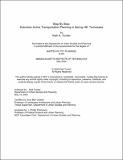Step By Step: Suburban Active Transportation Planning in Spring Hill, Tennessee
Author(s)
Tucker, Keili A.
DownloadThesis PDF (5.337Mb)
Advisor
Ben-Joseph, Eran
Terms of use
Metadata
Show full item recordAbstract
Suburban form produces car dependency with its circuitous routes, segregated land uses, and sprawling development. Active Transportation (AT), defined as non-motorized travel modes such as walking and cycling, has the potential to provide suburban residents with alternative mobility options. In 2015, Spring Hill, Tennessee, a city with suburban form and no dense urban core, adopted a Bicycle and Greenway Plan (BGP) to develop an AT network. This thesis seeks to understand how AT network plans are institutionalized, maintained, and expanded through policy and other implementation tools in order to accelerate progress on the expansion of AT infrastructure in Spring Hill. The thesis begins with four case studies: Spring Hill, Tennessee; Jefferson County, Alabama; Apex, North Carolina; and Mississippi Mills, Ontario, Canada. The case studies revealed that infrastructure, policy-making, and social programs must go hand in hand for a successful network. The thesis continues with sixteen one-on-one interviews of municipal staff, elected officials, and local developers in Spring Hill. The interviews addressed perspectives on walkability, experiences with AT implementation, and ideas for improving citywide pedestrian accessibility. The interviews reinforced that separated land uses and sprawling development limit the potential for walkability. Additionally, they revealed that greenfield development has been responsible for the majority of the BGP build-out thus far. BGP implementation would benefit from more buy-in from the city through dedicated funding streams and better use of existing programs that target pedestrian infrastructure. This work contributes to Active Transportation research by investigating the unique challenges of establishing walkability in rapidly growing suburban places.
Date issued
2024-05Department
Massachusetts Institute of Technology. Department of Urban Studies and PlanningPublisher
Massachusetts Institute of Technology